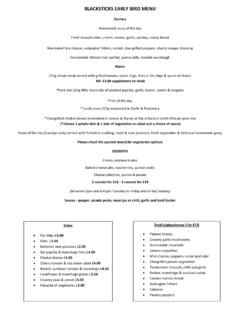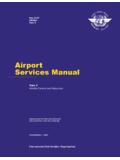Transcription of Highly pathogenic H5 avian influenza in 2016 and …
1 NO. 11 | NOV 2017. Highly pathogenic H5. Contributors: Les Sims, Timm Harder, Ian Brown, Nicolas Gaidet, Guillaume Belot, avian influenza in 2016 and Sophie von Dobschuetz, Akiko Kamata, Fredrick Kivaria, Elisa Palamara, 2017 observations and future perspectives Mirko Bruni, Gwenaelle Dauphin, Eran Raizman, Juan Lubroth Summary detection of viral incursions. In particular, the detection of a novel virus in wild birds on D uring 2016 2017 novel strains of Highly pathogenic H5 avian influenza virus within the Goose/Guangdong/96 (Gs/GD/96)-lineage the Tibetan plateau and surrounding areas largely devoid of commercial poultry pro- duction, (including northern Mongolia and (mainly H5N8) caused multiple outbreaks of southern Russian Federation), in May-June disease in poultry and wild birds across much of any year is likely to be followed later that of Europe, parts of Asia, the Middle East and year by detection of a similar virus in other West Africa, and have extended for the first distant countries, extending into Europe, time to affect poultry in Eastern and Southern South Asia and Africa.
2 Africa. The virus was reported first in the Tyva Evidence from earlier waves also suggests Republic in late May 2016 before being detected that the current virus could return to Europe in elsewhere. This was the fourth intercontinental 2017 2018, although the number of outbreaks wave of transmission by an H5 virus within this is expected to be lower than in 2016 2017. 1 lineage and was by far the most severe in terms In the current fourth intercontinental wave, Summary of the number of countries affected. the virus has been detected in a range of 2 Observations from earlier intercontinental farm types, intensive and extensive, with a Background outbreaks of Gs/GD/96-lineage H5 HPAI from higher proportion in domestic ducks, geese 2 2005 onwards may help forecast the probable and turkeys, but chickens have also been Clade course of this current panzootic,1 although it affected. Secondary spread between poultry H5N8 HPAI virus the fourth also demonstrates that the behaviour of H5 farms appears to have occurred in at least intercontinental wave HPAI viruses in this and previous waves has six European countries: Hungary, France, 11 varied.
3 If the reasons for these differences Conclusions and future perspectives can be determined, (viral, host and environ- 1. Panzootic: an outbreak of an infectious disease 12 mental factors), it may help improve fore- in animals that spreads across a large geographic Reference casting and hence preparedness and early region or even worldwide 1. NO. 11 | NOV 2017. Bulgaria, Germany, Poland and the United Figure 1a Kingdom, (APHA, 2017), but many appear to H5N8 HPAI outbreaks officially reported in Asia, Middle East, Europe and Africa by onset be primary cases not directly related to other date and bird type affected (domestic or wild), between 1 May and 31 December 2016. cases on poultry farms. At about same time as the H5N8 virus ap- peared in Europe an H5N6 subtype virus also within the Goose/Guangdong/96-lineage caused a massive outbreak of disease in layer chickens and ducks in the Republic of Korea.
4 This virus has not been detected there since early April 2017. Movement of both viruses has been associ- ated with infection in wild birds and their role in the long distance transmission of these viruses during the autumn migration is now irrefutable.. Background I n September 2016 FAO released an EMPRES Watch warning of the likely west- ward and southerly spread of H5N8 Highly pathogenic avian influenza (HPAI) virus during the northern hemisphere autumn and winter of 2016 2017. This warning was based on de- Note: The red oval denotes the first detection of the virus. tection of a novel H5N8 virus in wild birds at Lake Ubsu-Nur in the Republic of Tyva, south- and H5N6 viruses (APHA, 2017). The common (Gs/GD/96-lineage) H5 viruses belonging to ern Russian Federation, in late May 2016 (see feature of all of these Gs/GD/96-lineage vi- clade2 has occurred. These events in- Figure 1a, red oval). ruses is the H gene that can be linked back clude the fourth intercontinental wave involv- By October 2016, closely related viruses to the first occurrence detected in southern ing an H5N8 HPAI virus, likely associated with were detected in India and Europe and contin- China in 1996, the initial virus in the lineage.
5 Wild bird movements, as well as incursion of ued to spread throughout the autumn, winter Viruses in this lineage spread widely from another clade (H5N6) virus into the and spring of 2016 2017, eventually affecting 2003 onwards to more than 60 countries and Republic of Korea, Japan; (Okamatsu et al., 48 countries by the end of June 2017. In winter remain endemic to a number of them. 2017; Si et al., 2017; Lee, Song et al., 2017). and spring of 2017 virus detection continued This Focus On summarises observations and Taiwan Province of China, considered in to occur across Europe and cases were also from the current (fourth) intercontinental more detail later in the document. A wide detected in Nepal, north-eastern China, the waves associated with Gs/GD/96-lineage vi- range of avian species, both captive and wild, Republic of Korea and the Democratic Republic ruses as well as information on other related have been affected by the H5N8 HPAI virus of the Congo.
6 By May 2017 the number of new H5 viruses spreading in 2016 2017. It pro- (APHA, 2017). outbreaks in Europe had fallen dramatically but vides information on the genetics of these vi- Early warning of the fourth interconti- some new cases were still reported in June. ruses, some discussion on the likely progress nental wave was provided by the detec- New cases appeared in Turkey and extended of the current intercontinental wave and tion and reporting in June 2016 of a clade eastwards to multiple areas in the Russian guidance for forecasting future waves. Socio- H5N8 virus in wild birds in the south- Federation including the Republic of Tatarstan economic implications of the global spread ern Russian Federation on the border with and the Udmurt Republic. The virus spread to of H5N8 HPAI, while acknowledged as Highly Mongolia - Lake Ubsu-Nur (FAO, 2016a; Lee, southern Africa with an outbreak in a breeder important, are not covered in this report and Sharsov et al.)
7 , 2017; Marchenko et al., 2017). farm in northern Zimbabwe in late May, and will be reviewed separately. It is now recognised that a very closely relat- multiple farms in South Africa in June 2017. ed virus was associated with an earlier wild The 2016 2017 H5N8 viruses acquired Clade H5N8 HPAI virus bird die-off at Qinghai Lake, China in May genes from other low pathogenicity viruses 2016 (Li et al., 2017). Similar viruses have the fourth intercontinental wave circulating in wild birds, resulting in the emer- gence of multiple reassorted viruses includ- ing some that incorporated novel N5 or N6. genes and lost the N8 gene to produce H5N5. S ince May 2016, considerable Highly patho- genic avian influenza (HPAI) activity as- sociated with Goose/Guangdong/96-lineage 2. For Goose/Guangdong/96-lineage (Gs/GD/96-lineage). H5 clade nomenclature, please see Smith and Donis, 2015. 2. NO. 11 | NOV 2017. Figure 1b been detected in India (Nagarajan et al.
8 , 2017), across much of the Middle East and H5N8 HPAI outbreaks officially reported in Asia, Middle East, Europe and Africa by onset date and bird type affected (domestic or wild), in January 2017. Europe, and have spread into Africa where the extent of transmission is still being es- tablished. As of 30 June 2017 this virus has now been reported by 48 countries 29 in Europe, plus the Russian Federation, Egypt, Israel, India, the Islamic Republic of Iran, other parts of China, the Republic of Korea, Tunisia, Kazakhstan, Kuwait, Nepal, Nigeria, Niger, Cameroon, Uganda, the Democratic Republic of Congo, Turkey, Zimbabwe and South Africa. Locations of reported cases in poultry and wild birds in the fourth intercontinental wave as of 30 June 2017 in this wave are provided in Figure 1c. Unlike the previous intercontinental wave in 2014 2015, a novel Gs/GD/96-lineage virus has not been detected in North America in this wave.
9 In the current fourth wave, the virus has been found in a range of intensive and exten- sive farm production systems and species with a higher proportion in domestic ducks, geese and turkeys than chickens (on a population basis). Hungary, France, Bulgaria, Germany and Poland have all reported clusters of cases, some considered to be the result of secondary spread in poultry.. Figure 1c H5N8 HPAI outbreaks officially reported in Asia, Middle East, Europe and Africa by onset Earlier intercontinental HPAI. date and bird type affected (domestic or wild), between 1 February and 30 June 2017 waves similarities and differences The previous intercontinental waves of in- fection with Gs/GD/96-lineage H5 viruses provide some guidance on possible future events. The pattern and timing of H5N8. HPAI cases in this fourth transcontinental wave differ somewhat from those seen in the three previous intercontinental waves, (2005 2006, 2009 2010 and 2014 2015), de- scribed in the EMPRES Watch released in September (FAO, 2016a).
10 For example, the current wave has been more severe than all previous waves, in terms of the number of wild birds affected as well as affected farms and zoological collections, especially in Europe. More cases have also been detected in the northern hemisphere during summer 2017 than in previous waves. Nevertheless, there are some aspects that provide insights into the possible course of the epizootic (see Table 1). 3. NO. 11 | NOV 2017. Table 1. Comparison of the four Gs/GD/96-lineage H5 HPAI intercontinental waves Wave 1 2005 Wave 2 2009 Wave 3a 2014 Wave 3b 2014 Wave 4 2016. Clade of virus Clade (H5N1) Clade Clade Clade Clade (H5N8, involved and derivatives (H5N1) (H5N8, H5N2, H5N1) c (H5N1) H5N5, (H5N2?). Other H5 viruses Other H5 viruses Other H5 viruses Evolution of clade HA Gochang-like (related to clade HA Buan-like strains ( B sublineage). ,9). ( A sublineage) initially detected in Eastern China.)

















